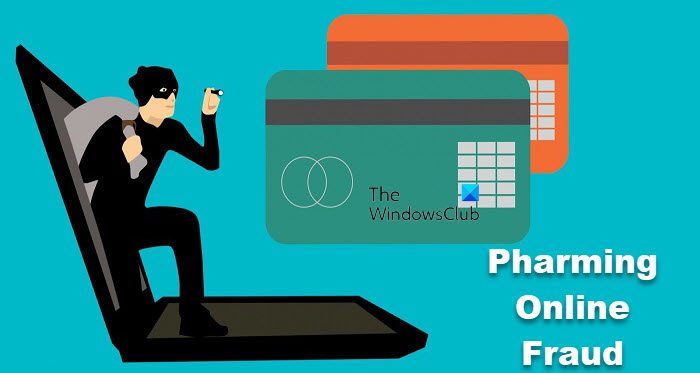When we look around, we are amazed at the speed with which the world is changing. Online fraud techniques such as Pharming and other cybercrime attacks are at an all-time high. To overcome such challenges, we need to have some basic understanding of these terms at least. This informational document intends to approach the problem with a solution.
What is Pharming Online Fraud

Pharming redirects Internet users from legitimate websites to malicious ones using a strategy called DNS Cache Poisoning – where corrupt data is inserted into the cache database of a DNS.
The attacker uses several ways to carry out pharming attacks, one of the most popular way is to modify the Host file. The Pharmer covertly hijacks your computer and takes you to a forged website. Your browser may display the legitimate URL, but you will not be on the legitimate server. This, in most cases, is a page that looks identical to that of your bank, financial institution or online shopping websites like, eBay, or Amazon. Here, the attacker seeks your confidential information like credit card numbers, account passwords, etc.
The Hosts file allows storing IP & domain names to speed up surfing and avoid consulting a DNS server. So, every time a user enters the address into the browser, the PC accesses the Hosts file first and, if it finds this domain name, it takes up the IP address of a website. Now if the Hosts file is modified, the user will be redirected to the wrong website, where the attacker will be waiting to steals the credentials.
To carry out a pharming attack, the attacker typically makes use of the following:
- A Batch Script to write the malicious IP and domain names onto the Hosts files.
- A Joiner to join the batch file onto another file
- A Code Obfuscator to help the executable escape detection from anti-virus software.
Phishing vs Pharming
You need to be clear about the difference between Pharming and Phishing. Phishing attacks start with the receipt of an e-mail asking you to visit a website where you may get compromised. Pharming attacks start at the DNS server level where you are redirected to a malicious website.
How to mitigate Pharming attack
Use an anti-virus program that protects you from unauthorized alterations of the Host file is one way. Also, you should regularly patch your operating system and the installed software.
More sophisticated pharming attacks target the DNS server which is usually handled by Internet Service Providers (ISPs). In such a scenario, a user has few options at hand to handle the risk and he can do little against it, except using trustworthy DNS servers.
Most browsers & security software today are capable of alerting users when landing at Pharming and Phishing sites. As such, a user should always remain vigilant while divulging details about financial accounts. Whenever in doubt, communicate using a secure network and do not reveal your credentials or any other requested information.
Precautions that can be taken to prevent Pharming
- Use a trusted, legitimate Internet Service Provider: Rigorous security at the ISP level is your first line of defense against pharming. Internet service providers (ISPs) are working hard on their end to filter out ‘pharmed’ sites.
- Better Antivirus software: Install an antivirus program on your Windows PC that does the right job for you. It is a good practice to buy an anti-virus system from a trusted security software provider to reduce your exposure to pharming scams.
- Keep computer updated: Get into the habit of downloading the latest security updates (or patches) for your Web browser and operating system to stay protected. Use a good secure web browser always.
- Double-check the spelling of a website: In most cases, it is observed that the attacker obscures the actual URL by overlaying a legitimate-looking address or by using a similarly spelled URL. So, always check the Web browser’s address bar to make sure the spelling is correct.
- Check URL: Check the URL of any site that asks you to provide personal information. Make sure your session begins at the known authentic address of the site, with no additional characters appended to it. But it is important to remember that your browser may display the legitimate URL, but you will not be on the legitimate server.
- Check the certificate: It takes a few minutes if not seconds to verify if a website page you’ve opened in the browser is legitimate or not. To check, go to ‘File’ in the main menu and select ‘Properties’. Alternatively, you can right-click your mouse anywhere on the browser screen and, select ‘Properties’ option. From the menu that pops up, click on “Certificates” and check if the site carries a secure certificate from its legitimate owner.
- Check the ‘HTTP‘ address: It is the safest and easiest practice to follow. When you visit a page where you’re asked to enter personal information, the ‘HTTP’ should change to https. The “s” stands for secure. This post will show you the difference between HTTP and HTTPS.
- Look for PadLock: A locked padlock, or a key, indicates a secure, encrypted connection, and an unlocked padlock, or a broken key, indicates an unsecured connection. So, always look for a padlock or key on the bottom of your browser or your computer taskbar.
Pharming is a serious concern and it’s on the rise. Although ISPs are taking the necessary efforts to provide filtering, we as a user should be more vigilant and exercise caution when using the Internet.
Read next about Whaling scams and Clickjacking frauds now!